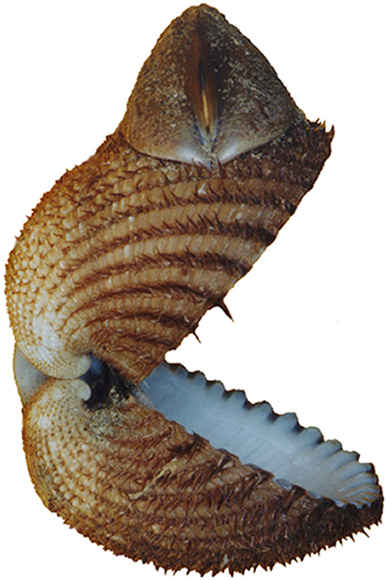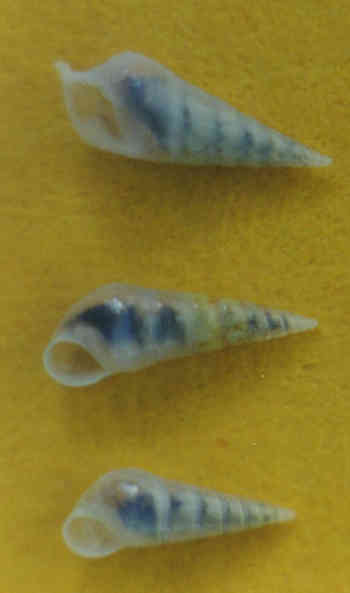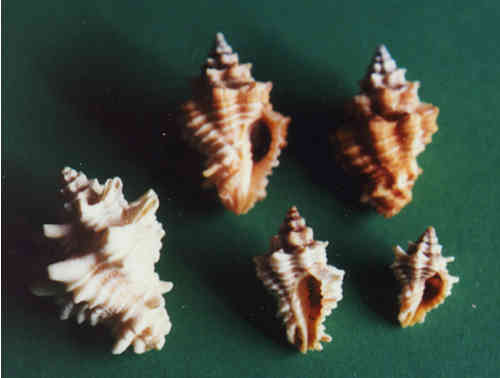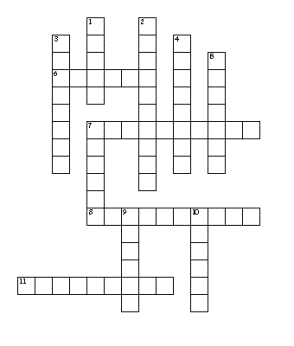
Newsletter of the Shell Club of Sydney
NSW Branch, The Malacological Society of Australasia Limited ACN 067 894 848

Anadara pilula
Courtesy Jules Leroi
Interesting shells from tropical Queensland
By Jules Leroi
One of the more common bivalves found on the sandy muddy littoral flats, near sea grass beds, is a comparatively small (30 - 35mm) arc shell which Iredale named
Potiarca pilula saccula (Iredale, 1939) (see Coastal N. Queensland Shells, P. Jansen). Springsteen, in "Shells of the Philippines", gives a description of an arc shell
Anadara (Potiarca) pilula (Reeve, 1843), which appears similar to
P. p. saccula, including shell characteristics such as having: strongly incurved umbones, sculptured with 26 granular radial ribs and a coarsely granulated inner margin. The main difference to me appears to be the internal Philippino shell is white, with a pale orange central area, while our shells appear to be predominately white (after bleaching the dark external periostricum). With so little significant difference between the Australian and Philippines shells, I prefer to call the Queensland shell:
Anadara pilula (Reeve, 1843). (See front cover photo)
Occasionally some A. pilulas are found to be burdened by a free -loader, a nut shaped mussel, which fits nicely on top of the inflated globose pilula shape. (also on front cover photo) "Bivalves of Australia", Vol 2., pages 86 & 87, identifies the mussel as being
Ciboticola lunata (Hedley, 1902). They are also found in the reference book "Queensland and Great Barrier Reef Shells", Rippingdale and McMichael. I have never found this mussel which is up to 30mm in length, anywhere else than on
A. pilula. Sometimes I have found 2 mussels on one A.
pilula. While rummaging amongst Anne's shells, I found a plastic bag containing an
A. pilula and a C. lunata with Yeppoon as it's locality. Previously I had only found this mussel at Shelly Beach, Pallarenda. Jack Austin (Phillip Island) has found these shells north of Cairns. The above suggests that the
C. lunata might occur along the tropical East Coast of Australia. I wonder if readers may have found these shells at other locations as well. If so could you let me know please? Glenda Rowse (Townsville) found her
C. lunata at Yeppoon on a carrier shell, but she can't recall the type of carrier.
The next family I will touch on, is the Eulimid family. Patty Jansen, in "The Sydney Sheller", October 1994, covered the
Hypermastus placentae fairly well. She quoted Warén extensively so I won't mention this species, apart from that I have surveyed Pallarenda Beach, where these species are readily located (near the pool). I found them not as plentiful as Warén mentions. They were on say 6 - 7% of the sand dollars and mainly on the larger ones. On searching 2 -3 km away from the pool, I could hardly find any. In places like Shelly Beach and Dingo Beach I haven't found any up to date. I must admit I haven't looked for these in any systematic way.
Peter Harvey from Mackay found some H. colmani Warén & Crossland, 1991 at Shoal Pt, Mackay on the large red sand dollar. (I have never found any Eulimids on the red sand dollar, but I must admit I have never shelled at Shoal Pt.)
Next I would like to mention the Eulimids Parvioris noumeae and Parvioris
fulvescens.

Parvioris fulvescens
Some sea stars harbour two types of Eulimids, the more common rather globose species and the rarer one which looks more like a Hypermastus
placetae. The globose species are Parvioris noumea and the slender ones are
Parvioris fulvescens. Both are parasites and have been found on the grey sea star.
At Dingo Beach, there are two types of common grey sea stars. One, not so plentiful, is much coarser than the more frequently occurring one, which is much finer and could be
Austropecten indicus or Austropecten polycanthus Müeller and Troschel 1842, but I don't know which, as I have no detailed literature on the subject. Most of the sea stars inspected are not infested with parasites. However, in June 1997, in one area among the sandy silty soil, I found some 8 -9 Austropecten, and every one had several and in some cases, 6-8 Eulimids on them. Their size varied from over 6mm in length to 4mm, 3mm and less. The protoconch under a magnifying glass, looks a little like an
Apicalia brazieri (Angas, 1877) or Echineulima ponderi
Warén, 1980 and these Eulimids have a yellowish operculum. (Visible in photo, bottom of next page). These Eulimids have been identified by Ian Loch (Aust. Museum) as being
Parvioris noumeae, so called presumably because they were first reported from New Caledonia.
Apart form having found some at Dingo Beach, they are also to be found at Shelly Beach, Pallarenda, in limited numbers and again I understand that Peter Harvey has also found them at Shoal Pt.
References:-
1. K. Lamprell & J. Healy: Bivalves of Australia, Vol. 2.
2. B. Wilson: Australian Marine Shells.
3. P. Jansen: Coastal N. Queensland Shells.
4. Springsteen & Leobrera: Shells of he Philippines.
5. Rippingale & McMichael: Qld and Great Barrier Reef Shells.
Turbinellidae Part 13
By Ulrich Knodel
Vasum capitellum Linne, 1758
The "Spiny Vase Shell" is a rather uncommon species and it descends form the Miocene species V.
guarbicum. Abbott (1950), had placed it in the sub genus Altivasum near the Australian species A. flindersi
but this is more spinose and has a much higher erected spire. Vokes (1966) has written: "Although
V.capitellum is a spinose form compared to other New World species, it is only slightly more spinose than the type of Vasum (s.s.) and the other Indo-Pacific species. Considering their phylogenetic history it seems unwarranted to place
V.capitellum and V. flindersi in the same group". (cit end)

Vasum capitellum
V.capitellum lives recent (no fossil records) in moderate deep waters at the Lesser Antilles and westward at the Northern coast of South America to Colombia. The type locality is (designated by Abbott, 1950) St Lucia, Lesser Antilles.
The shell is rather heavy and solid with, a rough surface: numerous axial lamellae cross the spiral rows of nodules which are often developed as short or longer sharp to blunt spines of different size; this species bears a great variation in spinosity. It has a pointed well-developed spire and a rather small, porcellaneous white aperture closed by a still smaller operculum. The usual size is 50 - 65 mm.
The first descriptions placed this species in Murex (by Linne) and in genus Voluta (by Gmelin); a synonym is
Volutella rubescens Perry 1811 and Turbinella nitidis
Lam.,1816.
Antibiotics from local Murex
Summarised from Sydney Morning Herald article 29/3/99
Background
Between 1600BC and the middle ages (for approximately 3000 years) there was only one known source of insoluble permanent purple dye, from a type of Mediterranean murex. Tyrian Purple was used for emperors clothes, tabernacle curtains and priests' vestments. To obtain one gram required harvesting 1,200 murex shells, and by 300 AD there were few left. As a result Tyrian Purple dye was one of the most expensive items on earth worth about 20 times its weight in gold, with production stopping completely by 1453. The pigments of some related NSW murexes have been recently studied for their antibiotic properties with promising results.
The research
Ms Kirsten Benkendorff, a doctoral student at the University of Wollongong has completed a study of 44 species of sea snails and sea slugs. 38 were found to have antibiotic properties. Of these 6 that are common between Sydney and Wollongong contain Tyrian Purple. Specifically the dye from the Common Dog Whelk has proved to be a powerful antibiotic at least as strong as Penicillin. She verified the effectiveness against marine bacteria and against human pathogens including staphylococcus, e-coli, candida, and pneumonia causing bacteria. Human cell tests indicate non-toxicity.
As its chemistry is very different to existing antibiotics, there is a good chance it will be active against
multi-drug-resistant strains.
The research was limited to anti-bacterial properties. Ms Benkendorff said it would be worth testing any anti-cancer properties, or if it is useful against viruses including HIV. The research only went into detail on the one species, the other 27 show equal potential.
It appears that the dog whelk use Tyrian purple to sterilise their egg masses, protecting them from infection.
The future
The chemical structure is simple enough to synthesise for large-scale production. An Australian pharmaceutical company is funding another doctoral student to synthesise the antibiotic compound found in the dog whelk.
Some notes on the use of cowries as money in West Africa
By John Dunkerley
We are doubtless all aware of past use of shells as money in India, Africa and elsewhere. However, possibly not all of us realise the quantities involved. The following snippets were gleaned principally from a recent book on the African Slave Trade (Hugh Thomas, The Slave Trade - The History of the Atlantic Slave Trade 1440-1870. Picador 1997. 923 pages).
European slave dealers typically purchased (rather than abducted) slaves, and many different cargoes were carried for this purpose - but cloth, metals, and shells, in that order, were the most important goods in the trade. Although Olives (especially Olivella nana) and Marginellas were used as currency in parts of Central and West Africa, Cowries were ubiquitous - in particular, Cypraea moneta and Cypraea annulus. Use of cowries as money seems to have been widespread in India by the tenth century AD (the word derives from the Hindi kauri), and cowries were carried across the Sahara by the eleventh century. By the end of the fifteenth century the Portuguese had rounded the southern tip of Africa, and were soon themselves taking cowries from the Maldives - they established a "fort" or trading post there in 1519.
In the early sixteenth century, slaves were sometimes sold for cowries alone, although more usually only a third or a half the price would be in cowries. In 1520 the standard price for a slave in Sao Tome was 6,000 cowries. Prices increased over time. At Whydah, Dahomey, in 1767, a slave might cost twenty cabess of cowries - a cabess was 5,000 cowries, making 100,000 shells in total. There are records of prices reaching 160,000 cowries per head.
One estimate is that between 1700 and 1800, over 25,000,000 pounds of cowries were imported into West Africa by European traders; 1,000 pounds equals 453.6 kg, so this is over 11 million kilograms! The peak year was probably 1722, when English and Dutch captains alone took well over 700,000 pounds (over 317,000 kg) of cowries to West Africa. Dr M. Schilder calculated that the Maldives exported 1,000 million cowries in the year 1800 alone; 300 million were taken from Zanzibar
1857-1868.
Cowries in West Africa were often strung in forties, which were known as tockies (from the Portuguese toque). Five tockies made a cabess, which, as noted, was 5,000 cowries. In eighteenth century Dahomey, the kings cut off the head of anyone who stole even a single cowrie. In terms of Western currency, in 1780, a British farthing (the smallest denomination) was equivalent to between 25 and 32 cowries.
Trade in shells continued to be substantial well into the nineteenth century. In 1841, the British government sent three steamers up the Niger River for legitimate trade, carrying six million cowries with them as money. The German explorer Heinrich Barth, in Timbuktu in the 1850s, saw a slave of "very indifferent appearance" exchanged for 33,000 shells; his host in Timbuktu, the Sheik El Bakay, also extorted an expensive gift from him - including 2 blue burnuses (cloaks) worth 100,000 shells, one kaftan costing 40,000, and two silk robes worth 35,000! By 1870, a new unit of cowrie currency had been created - a captif (ie, a "slave"), meaning 20,000 shells.
One must wonder at the numbers of cowries taken from the Maldives and elsewhere in the Indian Ocean for the West Africa trade. Although the reefs may have been in pristine condition when the trade began, and
Cypraea moneta and Cypraea annulus are "common species, how did the ecosystem sustain collection of these cowries in such quantities for so long? The shells must have been collected intertidally and in shallow water (which is their habitat), and presumably the collectors were not characterised by a high level of environmental awareness or concern - would they bother to turn boulders back over, or leave shells on eggs? Does any region in the world today supply shells in such quantities? If any reader has information on the present day shell trade (eg from the Philippines) it would be interesting to hear about it.
How to kill all marine life in a Darwin marina
Synopsis of an article in the Australian 3/4/99
The Zebra mussel Congeria saliei has triggered a nationwide quarantine alert.
At the end of March the mussels were discovered in a Darwin Marina.
The Northern Territory Primary Industry and Fisheries Department is taking no chances. It plans to deposit around 50 tonnes of chlorine into the Frances Bay Mooring Basin (a series of luxury marinas). It is seeking federal funding for the task.
This will kill the mussels (and from a collector's point of view, probably clean some of them in situ). It will also kill all other life in the basin.
The reason for such a radical plan, seems to be because much of Australia's Pearling fleet are moored in these marinas. This is an industry with exports worth over $10M annually.
Members News, & Buy, Swap & Sell:
Ernie Uhle advised that he also has a sinstral Turbo undulatus in his collection. It is fairly similar to the one pictured last month.
Since hearing this news, I (Steve Dean) am finding that I am now continually distracted by
Turbo undulatus in my trips to the headlands around Sydney. The thought of checking for sinstral specimines amongst the 10s of thousands in my field of view makes it difficult to concentrate my focus on more useful shells.
Crossword
Note: All clues can be found in this issue
Across:
6. The only way to dye
7. For holding roses
8. A parasite
11. Local shell unwinds |
Down:
1. Animal and mussel
2. Shell show in July
3. How much Chlorine?
4. Antibiotic shell, common in NSW
5. Shell money
7. A slave of cowries
9. Looks like a wart
10. 5,000 cowries |

Crossword answers:
zebra, townsville, 50tonnes, dogwhelk, annulus, tyrian, capitellum,
captif,fulvescens, lunata, cabess, undulatus
|




